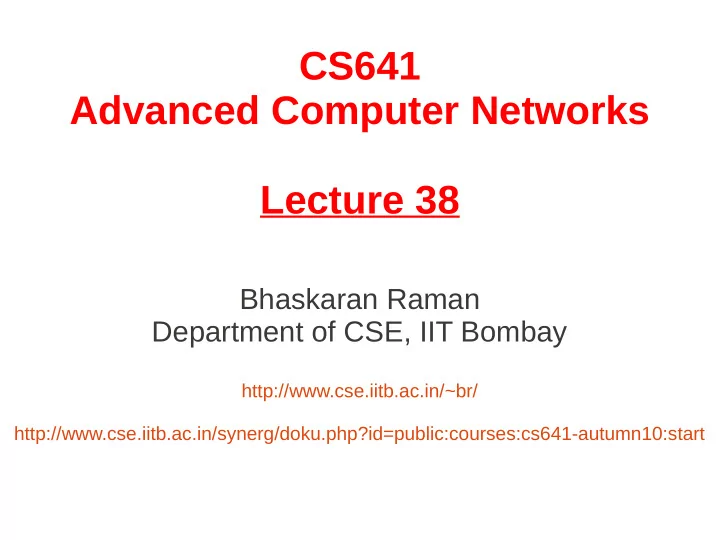

CS641 Advanced Computer Networks Lecture 38 Bhaskaran Raman Department of CSE, IIT Bombay http://www.cse.iitb.ac.in/~br/ http://www.cse.iitb.ac.in/synerg/doku.php?id=public:courses:cs641-autumn10:start
Outline for Today ● Chord: Distributed Hash Table ● Note next designated reading : – Due Tue 09 Nov 2010 – [KRH06] Sachin Katti, Hariharan Rahul, Wenjun Hu, Dina Katabi, Muriel Medard, Jon Crowcroft, "XORs in The Air: Practical Wireless Network Coding", ACM SIGCOMM, Sep 2006. – Focus on the first 5 sections (6.5 pages)
Peer-to-Peer Networks ● Peers form a network among themselves – Overlay on top of IP – Provide routing: usually towards named objects ● Classification – Centralized directory (e.g. Napster) – Decentralized directory ● Unstructured (e.g. Gnutella, FastTrack, Morpheus) ● Structured: topic for today
Structured Peer-to-Peer Networks ● Close coupling between network topology/addressing and data location ● Several distributed data structures proposed: – Chord – CAN (Content Addressable Network) – Tapestry
Peer-to-Peer Network Features ● Redundant storage ● Selection of nearby servers ● Searching of data ● Efficient location of data item
Non-Trivial Chord Features ● Load balancing ● Decentralization ● Scalability ● Availability ● Flexible naming
Chord Functionality ● Chord maps given key to a node – That node stores and serves data – Key space is flat – Can support dynamic node join/leave ● Application is responsible for other functionalities: – User friendly naming of data: hash to flat space – Authentication: use cryptographic hash – Replication: store data under two different keys
Example Applications ● Distributed indexing: Gnutella or Napster like keyword search ● Cooperative mirroring ● Time-shared storage ● Large-scale combinatorial search
The Chord Interface ● Two main interfaces with application above: – lookup(key) – Call back when the set of keys the node is responsible for changes
The Chord Lookup Protocol ● Logical identifier space, circular with m -bits ● Nodes and keys are hashed onto this space using SHA-1 – Nodes' IP addresses are hashed – Consistent hashing: load balancing ● Key k is assigned to successor node in identifier space – Reassignment happens when nodes join/leave
Scalable Key Location ● Default lookup method: – Maintain and follow successor pointers – Takes O(N) time for lookup ● Optimization: – Maintain finger table with at most m entries – The i' th entry will have the pointer to the first node s which is away from n by at least 2^(i-1) ● s = successor(n + 2^(i-1))
How the Finger Table Works ● Each node stores only a small number of pointers ● But an arbitrary node does not necessarily have pointer to successor(k) ● Node n searches its finger table for node j which most immediately precedes k ● In each step, we move closer to k – We at least halve the distance to k each time – O(logN) lookup time
Handling Node Join ● Invariants to maintain – Each node's successor is correctly maintained – For every k , successor(k) is responsible for k ● Maintain predecessor pointer for simplification ● Main steps when n joins: – Learn of some other node n' offline – Initialize own finger table and predecessor – Update fingers of existing nodes – Transferring keys ● O(logN * logN) messages
Some Remarks ● Handling simultaneous join, or node failure is a little bit more involved – Need to store r nearest successors – Need to replicate data associated with keys ● Protocol can be implemented iteratively or recursively ● Path length expansion is an important concern
Upcoming Topics ● Kazaa overlay measurement study ● Skype traffic analysis ● Designated reading: XOR, network coding ● Bloom filter, fast hash tables
Recommend
More recommend